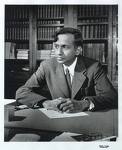 Biography of
Biography of 
Subrahmanyan Chandrasekhar
Tamil: சுப்பிரமணியன் சந்திரசேகர்
SUBRAHMANYAN CHANDRASEKHAR was born into a free-thinking,
Tamil-speaking
Brahmin family in Lahore,
India.
He was preceded into the
world by two sisters and followed by three brothers and four sisters.
His
mother Sitalakshmi had only a few years of formal education, in keeping
with
tradition, and a measure of her intellectual strength can be
appreciated from
her successful translation of Ibsen and Tolstoy into Tamil. His father
C. S.
Ayyar was a dynamic individual who rose to the top of the Indian Civil
Service.
It is not without interest that his paternal uncle Sir C. V. Raman was
awarded
a Nobel Prize in 1930 for the discovery of the Raman effect, providing
direct
demonstration of quantum effects in the scattering of light from
molecules.
Education began at home with Sitalakshmi giving instruction in Tamil
and English,
while C. S. Ayyar taught his children English and arithmetic before
departing
for work in the morning and upon returning in the evening. The reader
is
referred to the excellent biography Chandra, A Biography of S.
Chandrasekhar
(University of Chicago Press, 1991) by Prof. Kameshwar C. Wali for
an
account of this remarkable family and the course of the third child
through his
distinguished career in science. Chandra is the name by which S.
Chandrasekhar
is universally known throughout the scientific world. Chandra's life
was guided
by a dedication to science that carried him out of his native culture
to the
alien culture of foreign shores. The crosscurrents that he navigated
successfully, if not always happily, provide a fascinating tale. He was
the foremost
theoretical astrophysicist of his time, to paraphrase his own
accounting of Sir
Arthur Eddington.
The family moved to Madras
in 1918 as C. S. Ayyar rose to deputy accountant general. Chandra and
his
brothers had private tutors then, with Chandra going to a regular
school in
1921. His second year in school introduced algebra and geometry, which
so
attracted him that he worked his way through the textbooks the summer
before
the start of school.
Chandra entered Presidency College in Madras
in 1925, studying physics, mathematics, chemistry, Sanskrit, and
English. He
found a growing liking for physics and mathematics and an ongoing
attraction
for English literature. One can assume that his fascination with
English
literature contributed to his own lucid and impeccable writing style.
Chandra was inspired by the mathematical accomplishments of S.
Ramanujan,
who had gone to England
and
distinguished himself among the distinguished Cambridge mathematicians until his
early
death in 1920. Chandra aspired to take mathematics honors, whereas his
father
saw the Indian Civil Service as the outstanding opportunity for a
bright young
man. Mathematics seemed poor preparation for the Civil Service.
Sitalakshmi
supported Chandra with the philosophy that one does best what one
really likes
to do. Chandra compromised with physics honors, which placated his
father in
view of the outstanding success of Sir C. V. Raman.
On his own initiative Chandra read Arnold Sommerfeld's
book Atomic Structures and Spectral Lines and attended lectures
in
mathematics. His physics professors noticed that he was learning
physics
largely through independent reading and provided him with the freedom
to attend
mathematics lectures. In the autumn of 1928 Sommerfeld lectured at Presidency College. Chandra made it a point
to meet
Sommerfeld and was taken aback to learn that the old Bohr quantum
mechanics, on
which Sommerfeld's book was based, was superseded by the wave mechanics
of
Schroedinger, Heisenberg, Dirac, Pauli, et al., and that the Pauli
exclusion
principle replaced Boltzmann statistics with Fermi-Dirac statistics.
Sommerfeld
had already applied the new theory to electrons in metals and kindly
provided
Chandra with galley proofs of his paper. Chandra launched into an
intensive
study of the new quantum mechanics and statistics and wrote his first
professional research paper "The Compton scattering and the new
statistics" (1929). In January 1929 he communicated this work
to
Prof. R. H. Fowler at Cambridge for
publication
in the Proceedings of the Royal Society of London. The name Fowler
suggested itself
because Fowler had applied the new statistics to collapsed stars (i.
e., white
dwarfs). Fowler was an open-minded and generous individual who
perceived the
merit of Chandra's paper, which he duly communicated to the Royal
Society. This
contact was to play a crucial role a year later when Chandra arrived in
England.
 Biography of
Biography of 